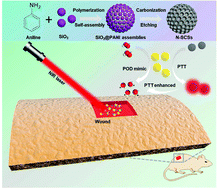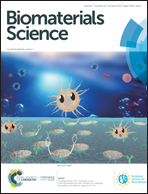Light-enhanced sponge-like carbon nanozyme used for synergetic antibacterial therapy†
Abstract
Bacterial infection and the issue of antibiotic resistance have become one of the major public health problems worldwide. Thus, searching for new antibacterial agents is urgently required. Hydrogen peroxide, H2O2, as a traditional bactericide, is applied widely for medical treatments. However, the relatively high concentration of H2O2 used in a clinical setting usually inhibits wound healing and even damages normal tissues during disinfection. Here, we synthesized N-doped sponge-like carbon spheres (N-SCSs), which showed excellent mimicking activities for multiple enzymes, including peroxidase, oxidase, superoxide dismutase, and catalase. We then utilized the peroxidase-like activity of the N-SCSs to convert low-concentration H2O2 into radical oxygen species to resist bacteria. The data showed that the antibacterial performance of H2O2 against Gram-negative bacteria (Escherichia coli), Gram-positive bacteria (Staphylococcus aureus), and multidrug-resistant bacteria was improved through the peroxidase-like catalytic reaction of N-SCSs. Importantly, besides generating heat against bacteria, near-infrared laser exposure also promoted the peroxidase activity of N-SCSs, to further generate radical oxygen species to kill bacteria. In addition, this catalytic-photothermal antibacterial strategy demonstrated accelerated recovery of infected wounds in an animal model. Thus, our work provides a new synergetic anti-infection strategy, and further expands the application of carbon-based nanozymes in biomedicine.



 Please wait while we load your content...
Please wait while we load your content...